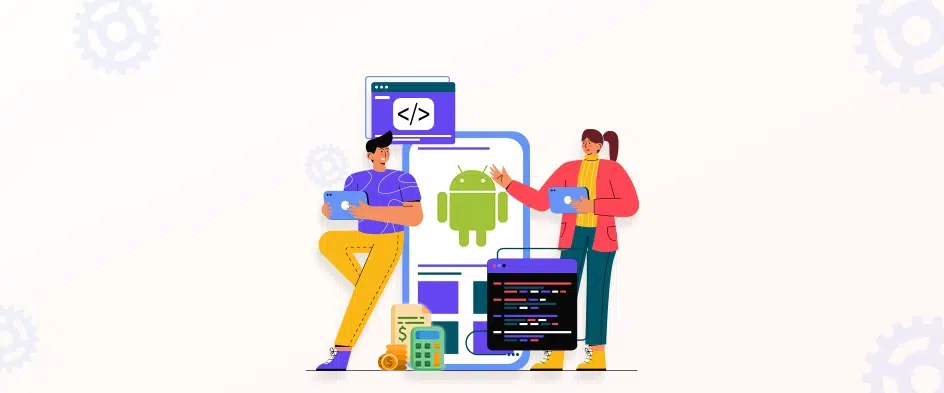Top Staffing Trends and their Impacts

- 5 Minutes to read
Table of Content
- Overview of the Current Staffing Landscape
- Top Staffing Trends
- What Drives the Staffing Trends?
- Impact of Staffing Trends on Businesses
- Summary
- FAQs on Staffing Trends
Are you trying to create high-quality websites or web apps? That would require the best skills and expertise in web development. So, you will need to stay up-to-date with strategies and techniques to attract and retain top talent.
Technology and globalization have brought about remote work. The top web development companies are more open to flexible arrangements to support their employees and increase productivity. Data-driven recruitment and selection is also on the rise, using analytics and algorithms to find the best candidates.
This blog will tell you all about how to hire the best staff for your project and the trends revolving around it.
Overview of the Current Staffing Landscape
The current staffing landscape in web development is characterized by a high demand for developers and a shortage of qualified candidates. This is due to a number of factors, including:
- The rapid growth of the web development industry
- The increasing complexity of web applications
- The rising demand for specialized web development skills
As a result, many web development companies are struggling to find and retain top talent. That has led to a number of trends in the web development staffing landscape. We’ll discuss these later on.
In terms of specific skills that are in high demand in the web development industry, some of the most sought-after include:
- Frontend development: Frontend developers are responsible for the look and feel of a website. They use technologies such as HTML, CSS, and JavaScript to create user interfaces that are both visually appealing and functional.
- Backend development: Backend developers are responsible for the server-side logic of a website. They use programming languages such as Python, Java, and PHP to develop the databases and application servers that power websites.
- Full-stack development: Full-stack developers have the skills and experience to work on both the front end and back end of a website. They are in high demand because they can provide a one-stop shop for a company’s web development needs.
- DevOps: DevOps engineers combine software development with IT operations to automate and streamline the process of software development and delivery. They are in high demand because they can help companies improve the quality and reliability of their software while also reducing the time and cost of development.
Overall, the current staffing landscape in web development is challenging but also exciting. There are many opportunities for qualified developers to find work and to advance their careers. However, companies that are looking to hire web developers need to be prepared to compete for top talent. To that end, let’s check out the top staff trends for convenient hiring.
Top Staffing Trends
So many companies are struggling to find and retain top talent. This has led to a number of trends in the web development staffing landscape, including:
- Increased demand for digital and technical talent: The demand for digital and technical talent is expected to continue to grow in 2023 as businesses increasingly rely on technology to operate and grow. This is particularly true in areas such as artificial intelligence (AI), machine learning (ML), and cloud computing.
- Remote work becomes the norm: Remote work has become increasingly popular in recent years, and this trend is expected to continue in 2023. As more and more employees opt to work remotely, businesses will need to adapt their staffing strategies accordingly.
- The gig economy continues to grow: The gig economy is another trend that is expected to continue to grow in 2023. Businesses are increasingly turning to freelancers and contractors to meet their staffing needs. This is due to the flexibility and cost-effectiveness of the gig economy.
- Compliance becomes more important: As the world becomes more interconnected, businesses are facing increasing compliance challenges. That is leading to a growing demand for staffing professionals with expertise in compliance.
- Automation and AI transform staffing: Automation and AI are already having a significant impact on the staffing industry. In 2023, we can expect to see even more automation and AI-powered tools being used to streamline and improve staffing processes.
- Focus on diversity and inclusion: Businesses increasingly recognize the importance of diversity and inclusion in the workplace. This is leading to a growing demand for staffing professionals who can help them build and maintain a diverse and inclusive workforce.
- Emphasis on employee well-being: Employee well-being is becoming a top priority for businesses of all sizes. This is leading to a growing demand for staffing professionals who can help them create a healthy and supportive work environment.
- Focus on data-driven decision-making: Businesses are increasingly using data to make decisions about all aspects of their operations, including staffing. This is leading to a growing demand for staffing professionals with expertise in data analytics.
Overall, the staffing landscape is constantly evolving. Businesses that want to stay ahead of the curve need to be aware of the latest trends and developments. By adapting their staffing strategies accordingly, businesses can ensure they have the talent they need to succeed.
What Drives the Staffing Trends?
The trends in staffing experienced personnel for creating websites or anything else are usually due to a number of factors, and we have listed some of them below.
- Economic conditions: When the economy is strong, businesses are more likely to hire new employees and expand their workforce. This can lead to an increase in demand for staffing services.
- Technological change: Technological change is constantly disrupting industries and creating new jobs. This can lead to changes in the demand for staffing services, as businesses need to find employees with the skills to use new technologies.
- Demographics: The demographics of the workforce are also changing. For example, the aging population is leading to an increase in demand for healthcare workers.
- Globalization: Globalization makes it easier for businesses to operate in multiple countries. This can lead to an increase in demand for staffing services, as businesses need to find employees who can work in different cultures and languages.
By understanding these factors, you can have a better grip on the current staffing trends to hire the best workforce for your projects and get the best results.
Impact of Staffing Trends on Businesses
The influence of staffing trends on businesses is huge. It has an effect on things like productivity, efficiency, and overall success.
Remote work is becoming more and more popular. It increases productivity levels due to the flexibility it offers, as well as less commuting time. That has improved the balance between work and life for employees. Companies also benefit by having access to a bigger talent pool, regardless of location.
The gig economy is another trend that involves hiring freelancers and independent contractors for particular projects. That has allowed the companies to get special skills while reducing costs on employee benefits and training programs.
Plus, focusing on diversity when it comes to staffing leads to enhanced innovation in businesses. Different views and experiences bring fresh ideas, making organizations stay competitive in the market.
Summary
For companies to stay updated on changing workforce dynamics and embrace new methods to source, recruit, and retain top talent, they need to be aware of the staffing trends. Some common staffing trends to hire the best skilled and experienced professionals for your company are as follows:
- Increased demand for digital and technical talent
- Remote work becomes the norm
- The gig economy continues to grow
- Compliance becomes more important
- Automation and AI transform staffing
- Focus on diversity and inclusion
- Emphasis on employee well-being
- Focus on data-driven decision-making
So stay updated and find the best staffer for your company. These trends will surely come in handy.
FAQs on Staffing Trends
1. How is remote work impacting staffing trends?
Remote work has become a significant trend in staffing due to its flexibility and cost-effectiveness. Employers are increasingly open to hiring remote employees, allowing them to access a wider talent pool and reduce office space expenses.
2. Why is diversity and inclusion an important staffing trend?
Diversity and inclusion have gained prominence in staffing trends as companies recognize the benefits of having a diverse workforce. It fosters creativity, innovation, and problem-solving while also reflecting the diverse customer base companies serve.
3. Are there any emerging staffing trends resulting from the COVID-19 pandemic?
Data analytics plays a crucial role in staffing trends by providing insights into recruitment metrics, candidate sourcing strategies, and employee performance. It helps organizations make data-driven decisions, streamline processes, and improve overall hiring effectiveness.



